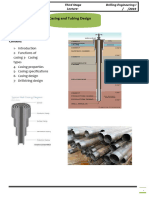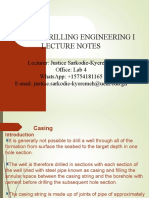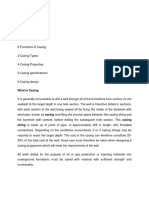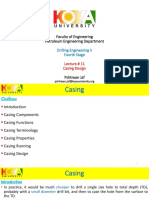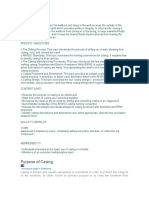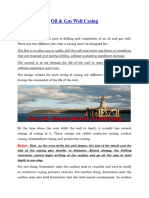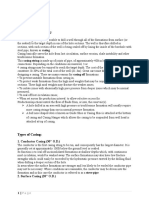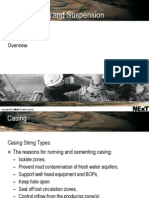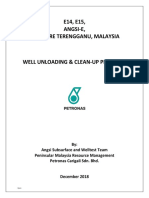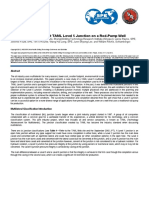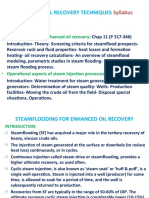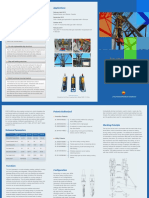PE:330
Oil Well Completion
)02( محاضرة
The Casing
عيسى مصطفى تابار. ا:المحاضر
استاذ مساعد في قسم الهندسة النفطية
Office: 3th Floor @ Engineering Labs building
Email: Essatabar@su.edu.ly
Phone/Whatsapp: (+218)919734091
Sirte University
Petroleum Engineering Department
�Oil Well Completion (PE330) Instructor: Ass. Prof. Mr: Essa Tabar
Letctur#02: The Casing
The Casing
Casing is a strong steel pipe used in an oil or gas well to ensure a
pressure-tight connection from the surface to the oil or gas reservoir. Casing
serves at least seven important functions in the well (fig. 1):
1. It prevents the hole from caving in or washing out.
2. It protects freshwater sands from contamination by fluids from lower
zones.
3. It keeps water out of the producing formation.
4. It confines production to the wellbore.
5. It contains formation pressures and prevents fracturing of upper and
weaker zones.
6. It provides an anchor for surface and artificial lift equipment.
7. It provides a flow path for produced fluids. In offshore operations, casing
also provides a conduit from the seafloor to a bottom-supported drilling unit,
such as a jackup, on the surface of the water
(1)
�Oil Well Completion (PE330) Instructor: Ass. Prof. Mr: Essa Tabar
Letctur#02: The Casing
Casing Strings
Casing is manufactured in joints that range in length from 16 to 48 feet
(ft) or 4.9 to 14.6 metres (m). It ranges in diameter from 4.5 to 48 inches (in.)
or 114 to 122 millimeters (mm) or more. Joints of casing are either screwed
or (occasionally) welded together as they are lowered into the hole. Several
joints of casing, when joined, constitute a casing string. Casing strings are run
concentrically, from the surface through the lowest interval with
hydrocarbon-bearing potential. The bit drills the hole to a certain depth, then
casing is run in to line it and, in most cases, cement is pumped in to bind the
casing firmly to the walls of the hole.
Types of Casing
One or more of the following strings of casing is required in every well
• Conductor Pipe
• Surface Casing
• Intermediate Casing
• Liner String
• Production Casing (tubing)
1. Conductor Pipe This is needed as a conduit to raise the circulating fluid
high enough to return the fluid to the surface pits. It also prevents washing
out from around the base of the rig. Conductor Pipe usually ranges from 30
to 42 inches in outside diameter offshore, and 16 to 24 inches onshore. Such
casing can be driven to 250 feet.
2. Surface Casing This is set deep enough to protect the well from cave-in of
loose formations that are encountered near the surface and to isolate the
fresh water formations. It is the starting point for the wellhead, and in most
cases serves as the base for the B.O.P stack during drilling operations and the
“Christmas Tree” if the well is completed for production. Surface casing can
(2)
�Oil Well Completion (PE330) Instructor: Ass. Prof. Mr: Essa Tabar
Letctur#02: The Casing
extend from hundreds up to nearly 2500ft. All later strings are suspended
and sealed at the top of the surface casing by means of a casing hanger.
3. Intermediate Casing The primary purpose of an intermediate casing string
is to protect the borehole. Usual functions of this string of casing is to protect
against lost circulation in upper zones and high-pressure zones deeper in the
well. In general, intermediate casing is set to seal off or protect some
problem area, and provide safety for further drilling.
4. Liner String Unlike casing, which is run from the surface to a given depth
and overlaps the previous casing, a liner is run only from the bottom of the
previous string to the bottom of the borehole. There is a minimal overlap
with the previous casing, and the liner is suspended in this overlap by means
of a liner-hanger. They are often cemented in place, but some production
liners are suspended from the previous string. Any type of casing can be used
as a liner.
5. Production Casing (Tubing) This serves to isolate the hydrocarbons during
production from undesirable fluids in the producing formation and from
other zones penetrated by the wellbore. It is the protective housing for the
pumps and other production equipment
Setting Production casing is the final casing in a well. The hole is drilled
beyond the producing interval. Production casing is set and cemented
through the pay zone. The casing and cement actually seal off the
producing zone
Installing the Tubing
Tubing is run into the well (smaller diameter compared to
production casing and removable) to serve as a way for oil or gas
to flow to the surface.
Packer is attached to it just near the bottom.
Packer is placed at a depth just above the producing interval.
(3)
�Oil Well Completion (PE330) Instructor: Ass. Prof. Mr: Essa Tabar
Letctur#02: The Casing
When the packer is expanded, it grips the wall of the production
casing and forms a seal between outside of tubing and inside of
casing
Installing the Christmas Tree
A collection of valves called a Christmas tree is installed on the
surface at the top of the casing hanger.
As the well’s production flows up the tubing, it enters the christmas
tree.
So, the production can be controlled by opening or closing valves on
the christmas tree
(4)
�Oil Well Completion (PE330) Instructor: Ass. Prof. Mr: Essa Tabar
Letctur#02: The Casing
(5)
�Oil Well Completion (PE330) Instructor: Ass. Prof. Mr: Essa Tabar
Letctur#02: The Casing
API standard steels and grades for pipes:
API has adopted a casing grade designation to define the strength characteristics of the
pipe. Each letter is characteristic of a chemical composition and sometimes imply a thermal
treatment. The number following the letter designates the minimum body yield stress guaranteed
by the manufacturer and is expressed in thousands of psi (see table 2-1). API define Casing as
tubular pipe with a range of OD’s of 4.5 to 20 in (see table 2-2). Pipe within this range are threaded
together, and those pipes over 20 in. OD are welded together.
Table 2-1: API Grade and mechanical properties of casing
(6)
�Oil Well Completion (PE330) Instructor: Ass. Prof. Mr: Essa Tabar
Letctur#02: The Casing
Running Casing
Prior to running casing, the hole will be cleaned (removing the cuttings and filter
cake) by doing one or more “short trips”. Once cleaned, a contract company will run
wireline logs. During wireline logging, the drill crew will prepare the rig for the casing
run. Once logging is over, the drillpipe elevator is removed and a heavy duty “slip”
elevator is installed to fit the casing. A “casing slip” is also installed over the rotary
table. A board is rigged up in the derrick (a “stabbing board”), so that the derrickman
can stand and handle the individual joints of casing and guide the elevators into
(7)
�Oil Well Completion (PE330) Instructor: Ass. Prof. Mr: Essa Tabar
Letctur#02: The Casing
position on the pipe. A pick-up line attached to the hook, raises the individual casing
joints into the derrick, then the joint is stabbed (connected to another). The casing
elevator is not latched to the full string of casing until the joint is made up. Following
this, the casing string is lowered through the rotary table and wedged with the casing
slips, ready to receive the next length of casing. Power tongs are used to ensure
proper make-up of each threaded joint. There is an arrangement for intermittently
filling the casing with mud as the string is run into the borehole. This prevents
collapse due to insufficient hydrostatic pressure inside the casing
Casing elevator
Casing slips
(8)
�Oil Well Completion (PE330) Instructor: Ass. Prof. Mr: Essa Tabar
Letctur#02: The Casing
Wellhead
This is the casing attachment to the B.O.P. or production (Christmas) tree.
It is a permanent fixture, bolted or welded to the conductor pipe or
surface casing. Wellheads installed on land rigs are located in the cellar,
on the spider deck on jack-ups and fixed platforms, and on the seabed
when used with barges, semi-submersibles and drillships. The wellhead is
the starting point for most blowout-preventer assemblies, and the vital
link between the casing and B.O.P. stack. The conductor pipe is not usually
provided with a pressure connection to connect the two. The surface
casing is nearly always welded to the wellhead (Figure 2-13a), and
subsequent casing strings are inserted inside the wellhead housing and
supported in a casing hanger (Figure 2-13b). Hanger assemblies are
designed to latch and seal inside the wellhead housing, so protection for
the sealing surfaces is needed while drilling. To achieve this, removable
sleeve-type protectors (called wear bushings) are installed in the wellhead
above the hanger. These are removed prior to running the next string of
casing.
(9)
�Oil Well Completion (PE330) Instructor: Ass. Prof. Mr: Essa Tabar
Letctur#02: The Casing
Wellhead
A wellhead is the component at the surface of an oil or gas well that
provides the structural and pressure-containing interface for the drilling
and production equipment.
Functions:
1. Provide a means of casing suspension.
2. Provides a means of tubing suspension.
3. Provides a means of pressure sealing and isolation between casing at
surface when many casing strings are used.
4. Provides pressure monitoring and pumping access to annuli between
the different casing/tubing strings.
5. Provides a means of attaching a blowout preventer during drilling.
6. Provides a means of attaching a Christmas tree for production
operations.
7. Provides a means of attaching a well pump,
The primary components of a wellhead system are:
1. casing head
2. casing spools
3. casing hangers
4. choke manifold
5. test plugs
6. tubing heads
7. tubing hangers
8. tubing head adapter
9. Christmas Tree
(10)
�Oil Well Completion (PE330) Instructor: Ass. Prof. Mr: Essa Tabar
Letctur#02: The Casing
Casing Head
It is a simple metal flange welded or screwed onto the top of
the conductor pipe Casing head also referred to as a casing bowl.
It is the lowest part of the wellhead assembly.
The bottom of the casing head is configured to attach to the
conductor casing.
The upper inside of the casing head provides bowl in which the
next casing can be set and sealed (if required).
The top of the casing head then connects to the next wellhead
compounds.
(11)
�Oil Well Completion (PE330) Instructor: Ass. Prof. Mr: Essa Tabar
Letctur#02: The Casing
Casing hanger installed around the casing and set into the casing head
allowing some of the casing weight to be taken and the string to be held
in a little tension.
Both casing head and casing spool assemblies may require the use
of the casing hanger.
Casing hangers attach to the end of a given casing string and
suspend and seal the casing string in the top bowl of a casing head
or spool.
(12)
�Oil Well Completion (PE330) Instructor: Ass. Prof. Mr: Essa Tabar
Letctur#02: The Casing
Casing Spool (Casing head Spool)
If the well includes one or more intermediate casing strings
between the surface and the production casing, the next
compounds required after the casing head is the casing spool
The bottom of the casing spool mounts on the top of the casing
head or pervious spool, and the top connects to the nest spool or
tubing head assembly.
(13)
�Oil Well Completion (PE330) Instructor: Ass. Prof. Mr: Essa Tabar
Letctur#02: The Casing
Casing Spool Functions
Provides for attachment to surface casing string
Supports blowout preventers while hole is drilled for next
casing string.
Provides suspending and packing off the next casing string.
Provide outlets for annular access.
Provides for testing BOPs while drilling.
(14)
�Oil Well Completion (PE330) Instructor: Ass. Prof. Mr: Essa Tabar
Letctur#02: The Casing
Tubing head
It provides means to suspend and seal the production tubing in the wellhead
Functions of Tubing Head
The function of the tubing head assembly is to:
suspend tubing with hanger
provide hydraulic seal between tubing and annulus
provide access ports to annulus
provide mounting for Xmas tree
(15)
�Oil Well Completion (PE330) Instructor: Ass. Prof. Mr: Essa Tabar
Letctur#02: The Casing
Tubing Hanger
A tubing hanger is also commonly known as a dog nut.
A tubing hangers suspend tubing and seal the annulus between the tubing
and the production casing.
Tubing hangers both suspend tubing and provide a primary annulus seal
between tubing and production casing.
Tubing Hanger adapter
The tubing head adapter provides a tension from the tubing head
to the Christmas tree
(16)
�Oil Well Completion (PE330) Instructor: Ass. Prof. Mr: Essa Tabar
Letctur#02: The Casing
Wear Bushing
While drilling the well, it is required that the seal bores in each of
the intermediate casing spools and tubing spools be protected.
A serious of wear bushings are supplied to protect the seal areas
discussed the drilling operation.
(17)





